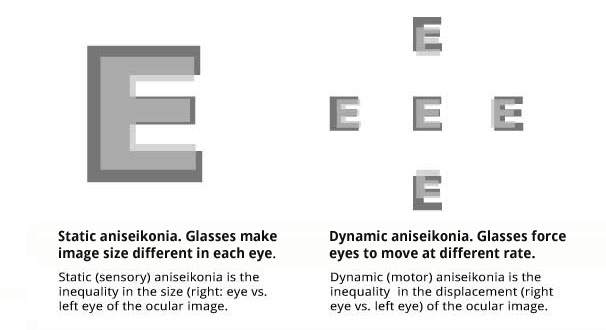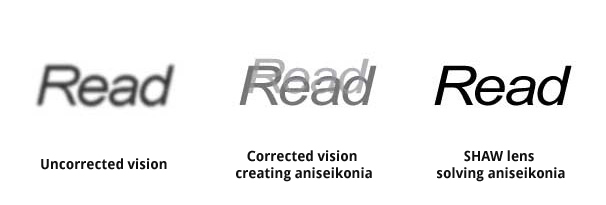There are two types of aniseikonia – static aniseikonia, in which the size of an image is different in each eye, and dynamic aniseikonia, in which the eyes are forced to track vertically and laterally at different rates. The SHAW™ lens is designed specifically to solve aniseikonia.

Static aniseikonia commonly occurs as a result of eyeglasses being made to correct anisometropia (eyes have different prescriptions). Basically, what happens with traditional eyeglasses design is that the approach is monocular in nature. The assumption is that if one lens makes the left eye’s vision crystal clear and another lens makes the right eye’s vision crystal clear, then the patient will be able to sort it out. The problem is that when you solve for anisometropia (different prescription for each eye), a monocular approach induces aniseikonia and makes the image sizes different in each eye. This creates a whole different set of problems for the wearer.
Now the brain has to work to fuse these different-size images together. In dealing with the images that the glasses make, the brain may try to adapt by fighting to focus all the time or by suppressing the image from one eye, or it may not adapt and instead react with headaches, vision distortion or other problems, and the patient just stops wearing the glasses for any length of time. Through our patented binocular optimization program, every SHAW lens is designed to effectively eliminate the difference in the size of images in each eye. This provides much better vision, depth perception and comfort in wearing glasses.
The SHAW lens is available through a select network of optometrists.
Click here to find one near you.

Dynamic aniseikonia is to the same concept as static aniseikonia, but with motion. If eyeglasses aren’t made with the consideration of how the two eyes move together, oftentimes the eyes are forced to move at different rates both vertically and laterally.
Eyes can converge (cross) easily. Just move your finger up to your nose – you can converge your eyes to keep it in focus. But human eyes were not designed to diverge (or move apart). When glasses are designed in a way that forces that to occur, our brains don’t like it. It’s just not a natural body movement. This can make reading difficult, as demonstrated here:

Dynamic aniseikonia can also cause problems for contact lens wearers.. Many complain of barrel distortion that makes it difficult to switch between glasses and contacts.
Because the sophisticated SHAW lens design software takes the patient’s individual tolerances into account when making glasses, the SHAW lens wearer can experience less blur and distortion in lateral and vertical gaze. If a patient is simply having issues adapting to a progressive lens design, then the SHAW lens won’t fix that. All progressive lenses have vision issues out to the lower sides.
HOWEVER, with our progressive lens design, we optimize the reading zone to a 23-degree angle of downward rotation. We take into account the position of the lens as it presents itself on your face with your frames, and we optimize the reading zone accordingly. In some instances, this can make a dramatic difference in the comfort of wear.
Our patent-pending method solves aniseikonia through sophisticated lens design software that models the physiology of how the individual patient’s eyes work in tandem – i.e., how the left eye moves in relation to the right eye in lateral (side to side) and vertical gaze. We do this using additional advanced measurements made by the optometrist, including motor fusion limits, position of wear and frame metrics.